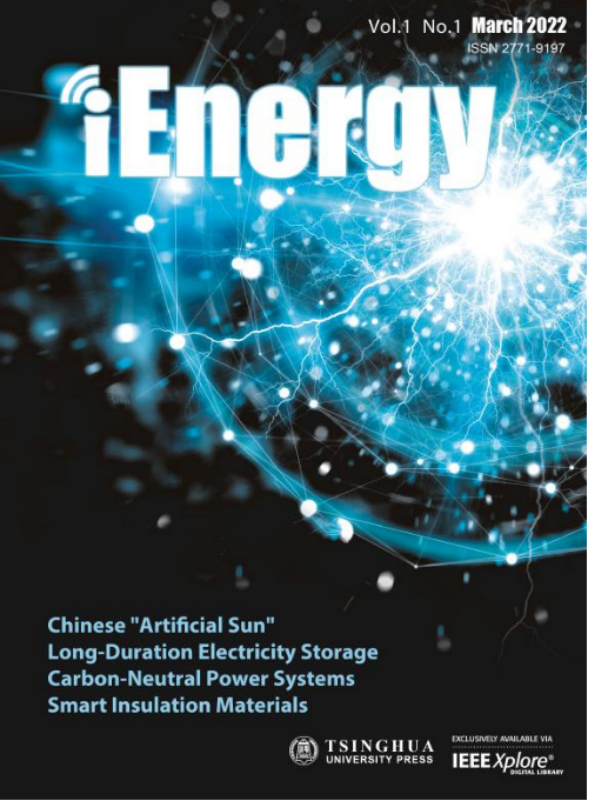
In March 2022, the open-access English international academic journal “iEnergy” sponsored by Tsinghua University was officially launched, with Professor He Jinliang from the Department of Electrical Engineering and Applied Electronics of Tsinghua University as the editor-in-chief. iEnergy is an interdisciplinary academic journal that publishes original research in all fields of power and energy, including cutting-edge scientific progress and engineering technology in power systems, high voltage, electrical machines, power electronics, energy material, new energy and integrated energy, etc., providing a dissemination platform for the latest scientific and technological progress of the future generation of power and energy systems. In the first volume of 2022, a total of 3 news and opinion articles, 1 short article, 4 reviews and 4 original research papers were published. The following is an brief introduction to the articles.

1. Author: EAST Team
Title: China’s Experimental Advanced Superconducting Tokamak sets new world record
iEnergy, (2022), 1:3-3
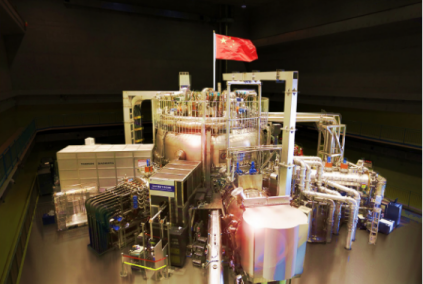
Experimental advanced superconducting Tokamak
Brief: Nuclear fusion is of great significance in the study of clean energy issues, as fusion energy is considered to be the ideal “ultimate energy” for the future of mankind. However, how to maintain the combustion plasma for a long enough duration and high duty cycle is a major challenge for fusion energy research. Superconducting Tokamak devices can achieve long-pulse operation, but need to comprehensively solve key technical and physical problems. On the evening of December 30, 2021, the Experimental Advanced Superconducting Tokamak (EAST) team from the Institute of Plasma Physics, Chinese Academy of Sciences set a record for long-pulse operation and achieved 1056 seconds of stable steady-state high-temperature plasma operation. This result symbolized that EAST has become the first Tokamak with a pulse length of a thousand seconds, the success of the experiment is a milestone on the road to exploring fusion plasma. The ultimate goal of EAST is to create sun-like nuclear fusion that uses the rich deuterium in the ocean to provide a steady stream of clean energy.
2. Author: Peng Xianjue
Title: Important issues in the science of nuclear energy
iEnergy, (2022), 1:4-8
Brief: Nuclear power generation has many advantages in terms of technological sophistication, economics and sustainability. Compared with hydropower, photovoltaic and wind power, it is uninterrupted and not restricted by natural conditions, and is a clean energy that can replace fossil energy on a large scale. The economics and efficiency of nuclear energy can provide an effective low-carbon solution. However, there are still deviations and deficiencies in the current understanding of some problems in nuclear energy science. Academician Peng Xianjue from the Chinese Academy of Engineering Physics discussed nuclear energy in economic cost, safety performance, energy source, choice of inertial confinement fusion technology, and magnetic confinement fusion technology. He pointed out that nuclear power should be gradually established as the main base-load energy, and the future energy should be a symbiotic intelligent energy system composed of nuclear energy and renewable energy with adjustable output power.
3. Authors: Chen Xinyu, Liu Yaxing, Zhang Yuxin
Title: Pathway toward carbon-neutral power systems in China
iEnergy, (2022), 1:9-10
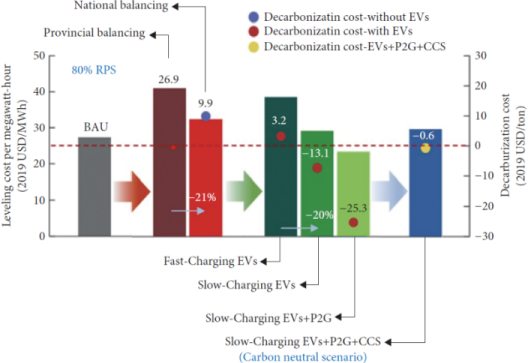
China’s decarbonization cost in different carbon neutral scenarios in 2050 at 80% renewable energy penetration
Brief: Professor Chen Xinyu’s team from Huazhong University of Science and Technology published the latest research result on how China’s power system can achieve the great vision of carbon neutrality in the middle of this century in the internationally renowned journal Joule. By developing a cross-departmental and high-resolution evaluation model, the energy structure of each province in China in different years is quantified, the operation of the power system in each province is simulated, and the optimal transformation path of China’s power system is described. The study pointed out that rational planning is crucial to the realization of carbon neutrality in China’s power system, and the development of offshore wind power, the construction of inter-provincial ultra-high voltage transmission grids, and the layout of electric vehicle charging facilities will all be key factors in the future energy transition.

1. Authors: Guo Jianbo, Ma Shicong, Wang Tiezhu, Jing Yiran, Hou Weilin, Xu Haotian
Title: Challenges of developing a power system with a high renewable energy proportion under China’s carbon targets
iEnergy, (2022), 1: 12-18
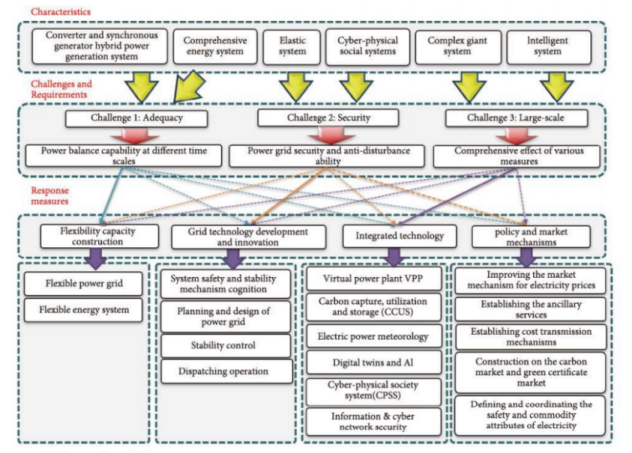
Key technology roadmap
Brief: The dual carbon goal is a major strategic decision for China to solve resource and environmental constraints and achieve sustainable development. It is an important commitment to building a community with a shared future for mankind, and also a hard and complex systematic project. Power system is the center of energy transformation, and the construction of a new power system is of significance for realizing the dual-carbon goal. This paper draws out the future energy and power development scenarios in China under the dual carbon target, and analyzes the challenges faced by the development of power system from in three points: balance, security and market mechanism. Then it summarizes six characteristics of China’s future power system, including converter and synchronous hybrid power generation system, integrated energy system, flexible system, cyber-physical social system, complex giant system and intelligent system. Finally, it introduces the relevant research and practice in China in recent years.

1. Authors: Huang Xiaoyan, Han Lu, Yang Xiao, Huang Zhiwen, Hu Jun, Li Qi, He Jinliang
Title: Smart dielectric materials for next-generation electrical insulation
iEnergy, (2022), 1: 19-49
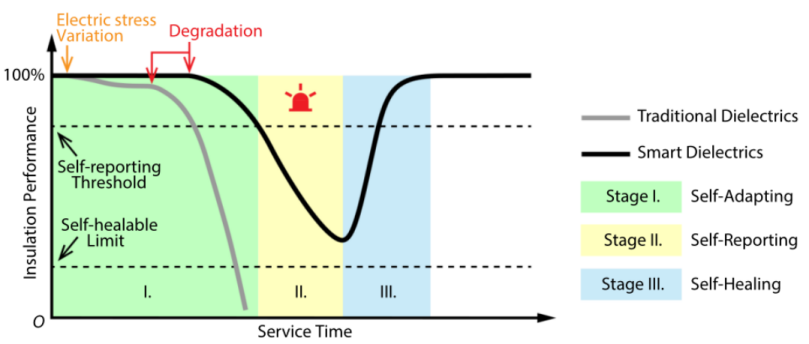
Life-cycle control of next-generation electrically insulating smart biomimetic dielectric material
Brief: Inspired by nature, it is expected to develop intelligent biomimetic dielectric material for next-generation electrical insulation. This self-adaptive, self-reporting and self-repairing dielectric can be used to avoid, diagnose and repair electrical damage to the material itself, avoiding equipment failure and massive power outage it induces. Compared with traditional dielectrics, the application of smart material not only improves the stability and durability of power devices, but also reduces manufacturing cost. This article introduces the research status of self-adaptive, self-reporting and self-repairing dielectric material in the field of electrical insulation, as well as inspiring research on biomimetic smart dielectric polymers in other fields, and briefly introduces the design principles, synthesis methods, action mechanisms, application scenarios and existing challenges of these material.
2. Authors: Zhubing Han, Qing Wang
Title: Recent progress on dielectric polymers and composites for capacitive energy storage
iEnergy, (2022), 1: 50-71.
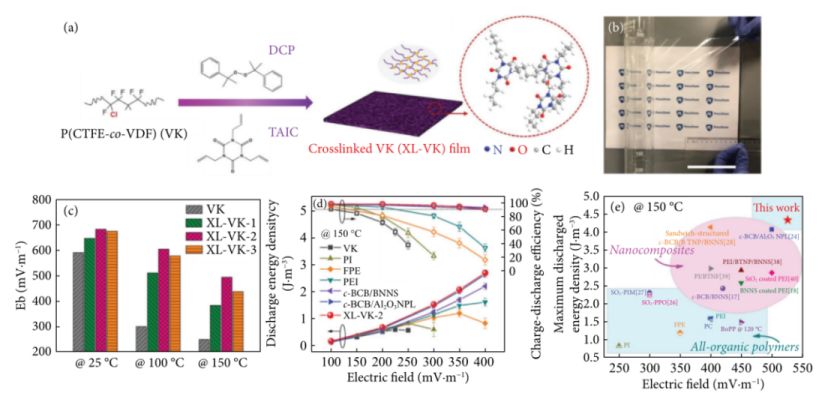
A simple method for preparing cross-linked P (CTFE-VDF) film
Brief: Capacitors based on polymer dielectrics are essential for the development of increasingly complex, miniaturized and sustainable electronic and electrical systems. However, the development of current polymer dielectrics is limited by low discharge energy density, low efficiency, and poor high-temperature performance. The authors review recent advances in the development of high-performance polymers and composite dielectrics for capacitor energy storage at room and elevated temperatures (≥ 150 °C), emphasize basic principle of material development by building a relationship between the physical properties and the energy storage capacity of the material, and discuss the challenges and future opportunities.
3. Authors: Liu He, Cheng Xinbing, Yan Chong, Li Zeheng, Zhao Chenzi, Xiang Rong, Yuan Hong, Huang Jiaqi, Elena Kuzmina, Elena Karaseva, Vladimir Kolosnitsyn, Zhang Qiang
Title: A perspective on energy chemistry of low-temperature lithium metal batteries
iEnergy, (2022), 1: 72-81
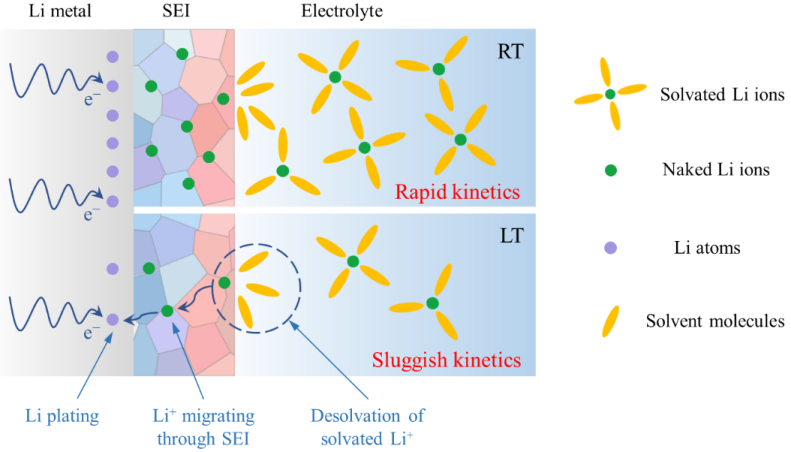
Comparison of the process of transferring lithium ions from the electrolyte to the electrode surface to obtain electrons and converting them into lithium metal at room temperature and low temperature
Brief: Lithium dendrite growth seriously hinders the practical application of lithium metal cathode. The transport kinetics of lithium ions at low temperatures is slowed down, and the dendrite growth is more serious. This prospect aims to reveal the energy chemistry of lithium metal cathode under low temperature conditions (below 0°C), and provide a basis for improving the low temperature performance of lithium metal batteries. (1) Reveal the low-temperature chemical characteristics of metal lithium batteries compared with traditional lithium-ion batteries via comparison, and discuss the opportunities and challenges of low-temperature lithium metal cathode; (2) Understand the low-temperature strip deposition behavior of metallic lithium cathode on the basis of the transport behavior of lithium ions and the characteristics of solid-state electrolyte interface (SEI) at low temperature; (3) Conclude the policies for improving the low-temperature lithium ion transport rate and inhibiting dendrite growth with respect to electrolyte design (low-temperature ionic conductivity and solvation structure) and electrode/electrolyte interface regulation. Finally, reveal the prospects and challenges of high-performance low-temperature lithium metal batteries.
4. Authors: Qu Ronghai, Zhou You, Li Dawei
Title: Milestones, hotspots and trends in the development of electric machines
iEnergy, (2022), 1: 82-99
iEnergy, (2022), 1: 82-99
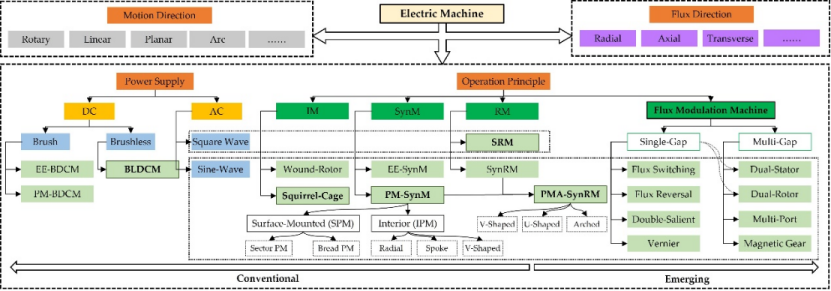
Classification of electric machines
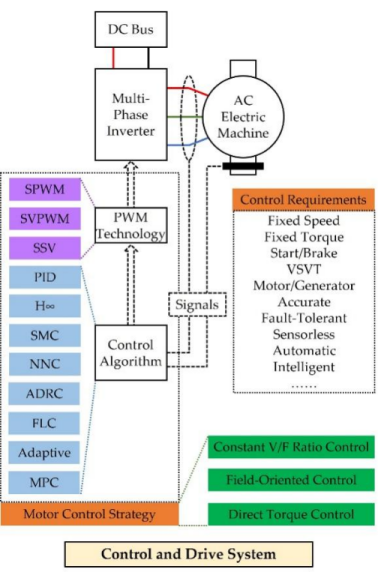
Schematic diagram of control and drive systems
Brief: Electric machines are one of the greatest inventions of mankind, as they realize the mutual conversion between electric energy and mechanic energy, bring human into the electrification era, and significantly promote the society development. This article briefly reviews the progress in electric machines over the past two centuries, and reveals some milestones and the force behind them. Electric machine topology is evolving and being innovated with innovation of theories, advancement of material, and breakthrough in computer science and electric and electronic devices. It not only summarizes the basic principle and performance features of traditional electric machines, but also introduces some new machines. Meanwhile, it further describes some control and drive units, as they are nonnegligible in electric machine systems. With global carbon emission reduction, industrial intelligentization and transportation electrification, electric machines are entering a new period of development, and this paper analyzes and concludes the future of electric machines.

1. Authors: Slavko Mocevic, Jianghui Yu, Boran Fan, Keyao Sun, Yue Xu, Joshua Stewart, Yu Rong, He Song, Vladimir Mitrovic, Ning Yan, Jun Wang, Igor Cvetkovic, Rolando Burgos, Dushan Boroyevich, Christina DiMarino, Dong Dong, Jayesh Kumar Motwani, Richard Zhang
Title: Design of a 10 kV SiC MOSFET-based high-density, high-efficiency, modular medium-voltage power converter
iEnergy, (2022), 1: 100-113
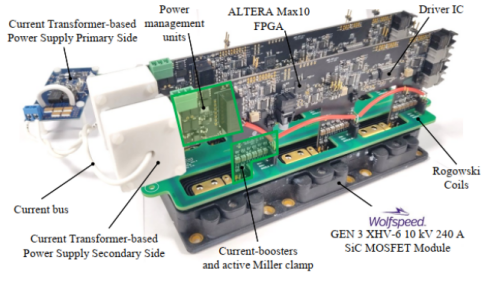
System architecture diagram of the developed medium-voltage half-bridge power unit
Brief: MV power electronic converters are extensively used in power systems, ship propulsion and high-speed railway, etc, and it is of great significance to improve their efficiency and power density. Compared with traditional silicon-based power electronic devices, the new HV carbonized silicon-based devices are more potential in application, however, they are facing great challenge from more serious EMI and higher requirement for insulation. In this paper, a research team from Virginia Polytechnic Institute and State University discloses their most updated achievement in HV carbonized silicon-based power electronic modules, including key technologies such as high-performance grid electrode drive, auxiliary power supply based on wireless power transmission, and stray inductance reduced PCB planar DC busbar. These power electronic modules have realized higher power density (11.9 kW/L) and efficiency (> 99%) than traditional solutions. This paper also introduces related studies on modularized multi-level converters based on these power electronic modules.
2. By Danny Pudjianto, Goran Strbac
Title: Whole system value of long-duration electricity storage in systems with high penetration of renewables
iEnergy, (2022), 1: 114-123
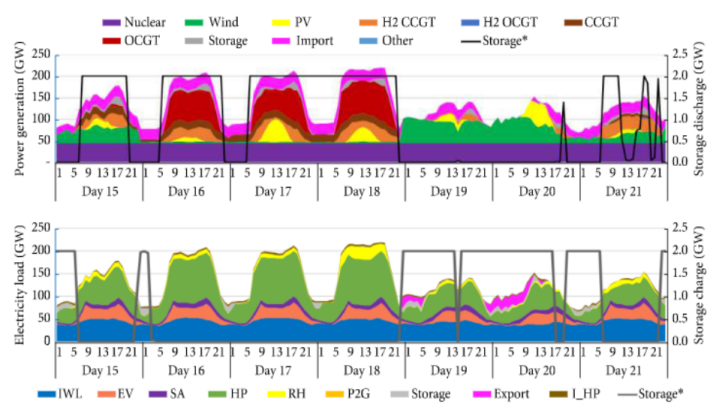
Simulation of UK power system operation considering long-term energy storage
Brief: Energy storage is a critical technology to accelerate renewable energy consumption and power system decarbonization. To position and quantize long-term electric power energy storage during the transition to a low-carbon energy system, Professor Goran Strbac’s team of Imperial College London put forward an energy system in consideration of electricity-hydrogen coupling. Under the target of net-zero emission of high-proportional renewable energy system in Britain by 2050, this article analyzes the impact of long-term power energy storage on the power generation structure, hydrogen storage demand and offshore wind power in various scenarios, revealing that energy storage is important for low-carbon energy transition, and long-term energy storage can improve the energy system and reduce the system cost.
3. Authors: Yao Rui, Zhao Dongbo, A. P. Sakis Meliopoulos, Chanan Singh, Joydeep Mitra, Qiu Feng
Title: Advanced extended-term simulation approach with flexible quasisteady-state and dynamic semi-analytical simulation engines
iEnergy, (2022), 1: 124-132
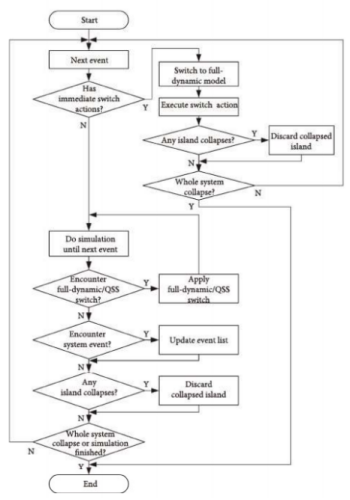
Long-term simulation flowchart
Brief: As power systems are evolving into complex systems with increasing interdependencies and richer dynamic behaviors at various time scales, many power system analysis (such as resilience analysis, renewable energy integration, and cascading long-term simulations) are involved in long-term simulation, so an efficient and robust long-term simulation method is urgently needed. Traditional methods are insufficient to handle long-term simulations of multi-time-scale processes. This paper proposes a long-term simulation method based on the semi-analytical simulation (SAS) method. Benefiting from the high accuracy of SAS in event-driven simulations, larger adaptive time steps, and flexible switching between fully dynamic and quasi-steady-state (QSS) models, this method is more accurate and computationally efficient than traditional methods. Test cases show that the proposed simulation method has satisfactory accuracy and efficiency, and can be used to simulate complex power system processes such as grid restoration, cascading faults, and outages.
4. Authors: Wu Dongqi, Rayan El Helou, Xie Le
Title: Towards an AI-friendly cross-time-scale simulation and analysis platform for electric distribution systems
iEnergy, (2022), 1: 133-140
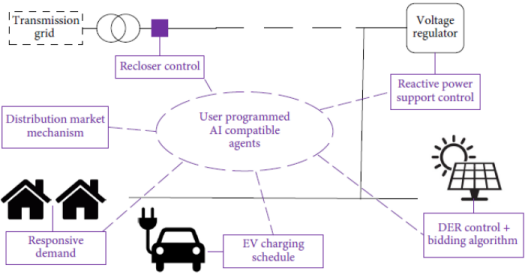
Conceptual diagram of artificial intelligence distribution network simulation analysis platform
Brief: Power system decarbonization not only forces power supply structure improvement at the power generation side, but also encourages new technology application at the distribution side for low-carbon energy transition. To analyze the interaction between a large number of energy end users and distribution grid operators, a team led by Professor Xie Le from Texas A&M University designed a comprehensive simulation and analysis platform AI4Dist for distribution systems, which integrates tools such as existing artificial intelligence and machine learning packages into power distribution system simulation, supporting simulations across time scales from market to transient. AI4Dist provides a comprehensive analysis platform for scholars with different professional knowledge to study power distribution systems.
(The interpretation of the articles only represents the views of iEnergy academic editors, the facts are subject to the original texts)
iEnergy Issue 1, 2022

Long press to identify the QR code&View the full articles
Download link https://ieeexplore.ieee.org/xpl/RecentIssue.jsp?punumber=9732629

















 News & Events
News & Events